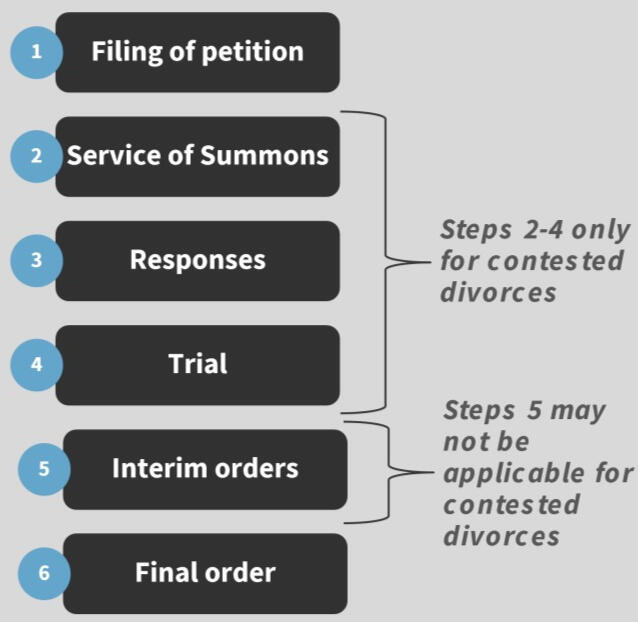
Facing a divorce? Here’s what you need to know
Divorce rate in India at ~1% is among the lowest in the world. However, the divorce rate has been rising sharply, especially in urban areas, driven sharply by the emergence of financial independence of working-class women and the evolving societal attitudes of men and women.
There is significant variation in the divorce rates across major states in India and may likely be tied to education, affluence, and awareness. Among large states, Kerala at 1.6% has the highest and Bihar at 0.2% has the lowest divorce rate in the country.
Divorce falls under the ambit of family courts at the district level in India. When one or both the parties approach the family court seeking a divorce, the court must first determine under which personal law would the matter fall under.
| Religion of parties | Applicable personal law |
|---|---|
| Both parties Hindu | William Gibson |
| Both parties Muslim | Muslim Personal Law |
| Both parties Christian | Indian Christian Marriage Act, 1872 |
| Both parties Sikh | Annand Marriage Act, 1909 |
| Both parties Jain | Jain Law |
| Both parties Buddhist | Hindu Marriage Act 1955 |
| If religions of both parties differ | Special Marriage Act, 1954 |
In this article, we detail the divorce under the Hindu Marriage Act, 1955. Section 13 of the Hindu Marriage Act 1955 talks about the grounds of divorce, while Section 125 and 126 of Criminal Procedure Code 1973 provides the order for maintenance of wives, children and parents, and the associated procedures for maintenance.
Grounds of divorce:
Among the grounds of divorce under the Hindu Marriage Act, 1955, the following five grounds are the most common:
1. Adultery: The act of indulging in any kind of sexual relationship including intercourse outside marriage. Adultery is counted as a criminal offense and substantial proof are required to establish it. An amendment to the law in 1976 states that one single act of adultery is enough for the petitioner to get a divorce.
2. Cruelty: When a spouse feels they are being subjected to mental and physical injury that causes danger to life, limb, and health. The intangible acts of cruelty through mental torture are not judged upon one single act but series of incidents.
3. Desertion: If one of the spouses voluntarily abandons his/her partner for at least a period of two years, the abandoned spouse can file a divorce.
4. Conversion: In case either of the two spouses convert into another religion.
5. Mental Disorder: If the spouse of the petitioner suffers from incurable mental disorder and insanity and therefore cannot be expected from the couple to stay together.
Other less common grounds for divorce include:
1. Leprosy or any communicable disease: If a spouse has ‘virulent and incurable’ form of leprosy or is suffering from a communicable disease such as AIDS, the other spouse can file for a divorce.
2. If the spouse has renunciated from the world or has not been “Not Heard Alive” for a period seven years. The latter could happen if the spouse is in the armed forces, for example.
3. No resumption of cohabitation: If the couple fails to resume their cohabitation (sexual relation) after the court has passed a decree of separation.
In addition, following are the grounds on which the women can file a divorce:
1. If the husband has indulged in rape, bestiality, or sodomy.
2. If the marriage is solemnized under the Hindu Marriage Act and the husband has again married another woman despite of the first wife being alive.
3. If married before the age of fifteen and wishes to renounce the marriage before she attains eighteen years of age.
4. If there is no cohabitation for one year and the husband neglects the judgment of maintenance awarded to the wife by the court.
Types of divorce:
There are two types of divorce cases – (1) Involving Mutual consent, and (2) Contested.
Mutual Consent:
Mutual divorce is governed by Section 13B of the Hindu Marriage Act. In mutual divorce, both the parties i.e., the husband and the wife mutually agree and express their consent for peaceful separation.
There are only two requirements for filing a mutual divorce:
(a) Mutual consent and
(b) Spouses having lived separately for at least one year
Contested Divorce:
When divorce is initiated by either spouse, it is termed as a “Contested Divorce”. Section 13 of the Hindu Marriage Act, 1955 provides the grounds for filing a contested divorce, some of which are mentioned earlier in this article.
Read more about contested divorce here.

Facing a mutual consent divorce?
Understanding the process
Process of divorce:
Broadly, following are the steps involved in any divorce:

There are fewer steps in mutually consented divorce. The courts expect and ask that the husband and wife have predetermined important issues relating to alimony and child custody. From then on, the process of getting a divorce becomes procedural and involves the following:
1. Petition:
a. Petition is drafted stating the reason for seeking a divorce that both the parties have agreed on.
b. Petition jointly filed before the family court.
2. Interim order:
a. The court after the examination of the petition along with the documents will pass on the order for the recording of the statement on oath.
b. After this, a cooling period of six months’ time is given to the parties in the hope of reconciliation.
3. Final order:
a. Post 6 months, if there is no reconciliation, both the parties need to appear for the final hearing. Parties must appear for the second motion within 18 months from the date of filing the divorce petition.
b. In the final hearing, the court passes the divorce decree dissolving the marriage
Documents for a mutual consent divorce:
Residence Proof of Husband and Wife.
Marriage Certificate.
Photographs of Husband and Wife.
Proof to show that mediation was unsuccessful, and the parties couldn’t be reconciled.
Evidence that husband and wife have been living separately for more than one year.
Details of husband and wife’s professions and present incomes.
Income tax statements of three financial years.
Information regarding the family background.
Details of the property and assets owned
Need for an advocate for a mutual consent divorce:
In mutually consented divorce, while parties can file the divorce on their own without consulting any advocate, it is recommended to hire an advocate. An experienced advocate can help comply with the procedures, ensure downside protection in case either spouse would like to contest the terms, and develop documentation that captures the essence of the terms between the couple on issues such as alimony, property, child custody, etc.
Associated Legislation:
Hindu Marriage Act, 1955
Protection of Women from Domestic Violence Act, 2005 (PWDVA)
Prohibition of Child Marriage Act, 2006
Criminal Procedure Code, 1973 (CrPC)
Indian Penal Code, 1860
Hindu Minority and Guardianship Act, 1956
Landmark judgements:
Read some landmark judgements that have shaped the way our family courts approach divorce cases.

Facing a divorce?
Landmark Judgments
Landmark judgements:
Read some landmark judgements that have shaped the way our family courts approach divorce cases.
1. Samar Ghosh Vs. Jaya Ghosh
In this case the Supreme Court issued a list of examples depicting mental cruelty. The list, on the other hand, is not exhaustive, it can be called mental cruelty if a person refuses to have intercourse for a prolonged period of time without any physical incapacity or legitimate cause. It can be considered mental cruelty if either husband or wife chooses not to have a child after marriage.
Even ill-treatment by in-laws would amount to mental cruelty and apart from this if the husband or the wife undergoes sterilization or abortion without the knowledge or consent of the spouse may also amount to mental cruelty.
Mere coldness or lack of affection cannot amount to cruelty, frequent rudeness of language, petulance of manner, indifference and neglect may reach such a degree that it makes the married life for the other spouse absolutely intolerable.
2. Naveen Kohli Vs. Neelu Kohli
In this case, the appellant Naveen Kohli & the respondent Neetu Kohli got married on November 20th, 1975 & had three sons. Soon, they started having altercations. The Family Court ordered the cancellation of marriage between both the parties under Section 13 of the Hindu Marriage Act, 1955, and directed the appellant to pay to the respondent Rupees 5 lakhs as her and children’s livelihood allowance.
However, this order of the Family Court, of the Kanpur City was overruled by the Division Bench of the Allahabad High Court and the matter was appealed to the Supreme Court. The Court held that the findings of the High Court were completely unsustainable.
The Court agreed with the observations of the family court that the matrimonial bond between both the parties was beyond repair. There was so much hate between them that they used to altercate in the courtroom and make allegations at each other. Therefore it was held by the supreme court of India that the public interest and interest of all concerned lies in the recognition of this fact and to declare defunct de jure what is already defunct de facto meaning when the relationship is beyond restoration and its existence is nil, it is better to officially recognize the fact, for the benefit of all. It was recommended by the court to the government to incorporate an irretrievable breakdown of marriage as a ground for the grant of divorce.
3. Mayadevi Vs. Jagdish Prasad
In this case the Supreme Court held that, the Supreme Court held that any kind of mental cruelty faced by either of the spouses, not just the woman but men as well, can apply for a divorce on grounds of cruelty. In this case, the respondent filed an application of divorce after a repeated course of cruelty inflicted by his wife and as alleged by the husband (respondent) that the wife did not provide food to him and his children and blamed the husband and his family members instead. Hence, a man is also entitled to divorce if he is inflicted with any kind of cruelty.
4. Sureshta Devi Vs. Om Prakash
It was observed by the honorable Supreme Court, in this case, that the fact that a couple has together presented a petition by mutual consent for divorce suggests the fact that they are not able to live together. Therefore, the parties are not required to establish the fact that they have not been able to live together. In fact, the expression “not able to live together” indicates the concept of the breakdown of marriage, that is there is not a single hope left for any sort of reconciliation.
Whereas, it is very important to determine, whether the consent given by both the parties is free and not obtained by the use of any kind of force, coercion, fraud, or undue influence. If one of the parties at any stage says that “I have withdrawn my consent”, or claims “I am not a willing party to the divorce”, the Court will not pass a decree for divorce by mutual consent. If the Court is held to have the power to make a decree solely based on the initial petition, it negates the whole idea of mutuality and consent for divorce. Mutual consent to the divorce is a sine qua non for passing a decree for divorce under Section 13-B. If the parties have to avail a divorce then the mutual consent must continue till the decree of divorce has been passed.

Facing a contested divorce? Here’s what to expect.
In the precious article, we detailed the aspects of divorce under the Hindu Marriage Act 1955. This article goes into depth in case the divorce is contested i.e., the divorce has been legally initiated by one party without the consent of the other party.
Section 13 of the Hindu Marriage Act 1955 talks about the grounds of divorce, while Section 125 and 126 of Criminal Procedure Code 1973 provides the order for maintenance of wives, children and parents, and the associated procedures for maintenance.
As mentioned in the previous article, the grounds of divorce remain the same and include the following –
1. Adultery
2. Cruelty
3. Desertion
4. Conversion
5. Mental Disorder
Other less common grounds for divorce include:
1. Leprosy or any communicable disease
2. Renunciated from the world or “Not Heard Alive” for a period seven years.
3. No resumption of cohabitation
In addition, following are the grounds on which the women can file a divorce:
1. If the husband has indulged in rape, bestiality, or sodomy.
2. If the marriage is solemnized under the Hindu Marriage Act and the husband has again married another woman despite of the first wife being alive.
3. If married before the age of fifteen and wishes to renounce the marriage before she attains eighteen years of age.
4. If there is no cohabitation for one year and the husband neglects the judgment of maintenance awarded to the wife by the court.
Process of a contested divorce:
Broadly, following are the steps involved in a contested divorce:

To contest the divorce, one party must be able to convince the magistrate that one or more grounds for divorce exist and that the case must go to trial. If the magistrate allows the case to proceed, then the following steps are involved:
1) Petition:
a. The petitioner (the “plaintiff”) initiates a suite through filing a petition before a family court mentioning the facts of the case and the demands of the petitioner from their spouse i.e., the “defendant”. This petition is filed along with affidavits, vakalatnama, and relevant documents.
2) Service of summons:
a. If the court is satisfied after scrutinizing the petition and decides to move with the case, it sends a notice or summons the defendant to appear on a decided date along with his/ her lawyer.
3) Responses:
a. On summon date, the defendant shall submit his reply to the petition, and documents (called a “written statement”.)
b. Replication/Rejoinder by Plaintiff: After filing the written statement, the plaintiff can provide an answer to the reply given by the other party.
c. The court could suggest parties for mediation and if the mediation fails to resolve the issue, the court will continue with the proceedings.
4) Trial:
a. During trial, both the parties appear before the court, record their statements, submit evidence, get cross-examined and will present their witnesses if any.
b. Based on the statements of each other, the parties frame issues against each other.
c. The counsels from both sides will present their final arguments.
5) Interim order:
a. The court may pass an interim order. Any party can file before the court a temporary petition regarding maintenance and custody of the child by interim orders. It can be charged after the trial and the legal proceedings have been concluded. The order remains in effect until the divorce becomes final.
6) Final order:
a. Both the parties submit the summary of their case.
b. The court delivers the verdict and passes a divorce decree. The aggrieved party can appeal to the order passed within 3 months from the passing of such order.
Matters typical arising in a contested divorce:
While each case is unique and the outcome dependent on the facts of the case as well as the secretion on of the judge, the following matters and their precedence are listed:
1) Custody of the child:
The ultimate rule for granting child custody is that such custody should be in the ‘best interest of the child’. All the rules laid down above can be disregarded on a strong implication of affecting the ‘best interests of the child’ adversely.
If the court believes that the parents are unwilling or unable to take care of the child properly or in his best interest, then the court can award the custody of such a child to the close relatives or any capable third person.
A. Child under 5 years’ age: The custody of such a child is usually given to the mother as it is believed that the child of such a tender age needs affection and love which can only be provided by the mother.
B. Child between 5-18 years’ age: The custody of such a child is usually given to the father under the Section 6 of Hindu Minority and Guardianship Act, 1956.
C. The court while deciding on custody can provide the other parent (who is not entitled to custody rights) with visitation rights wherein the other parent can be given some time to visit the child. Such rights can be passed by interlocutory orders and can be modified to suit the changed circumstances.
2) Alimony:
There is no set formula or hard rule that decides how much alimony needs to be paid by either spouse to the other one. The alimony amount can be provided as a monthly or periodical payment or in the form of a lump-sum amount as a one-time payment. If the alimony is being paid in the form of monthly payments, the Supreme Court of India has set 25% of the net monthly salary that should be granted to the wife by the husband. In case, the alimony is being paid in the form of a lump-sum amount, it usually ranges between 1/5th to 1/3rd of the husband’s total worth.
Some other factors are taken into consideration while calculating the amount of money, which are-
A. Social status and living standard of both the parties.
B. The income of both husband and wife and other assets including properties
C. Dependents and liabilities of the husband
D. Child/children’s education and upbringing expenses
E. Health state and age of both the parties
F. The duration for which the couple has been married.
G. Behavior and conduct of both the parties
3) Distribution of Assets and property:
Assets which belong to the wife after the separation include:
A. Any type of jewelry including gold, silver, alloy and precious stones.
B. Fixed assets such as property
C. Other assets like cars, furniture, paintings, appliances, and artifacts
D. Gifts presented to her from anyone.
E. The earnings of the wife before or after marriage.Assets which cannot be claimed by wife after separation are-
A. The earnings of the husband before marriage.
B. Jewelry, valuables, or gifts gifted to the husband by the wife’s parents before, after or during the marriage.
C. Any asset purchased by the husband in the wife’s name without passing it on as a gift.
D. Any expense of the household done by the wife’s earnings cannot be claimed.
Documents for a contested divorce:
Residence Proof of Husband and Wife.
Marriage Certificate.
Photographs of Husband and Wife.
Documents proving the ground on which divorce is being filed.
Details of husband and wife’s professions and present incomes.
Income tax statements of three financial years.
Information regarding the family background.
Details of the property and assets owned.
Need for an advocate in a contested divorce:
In a contested divorce, the presence and quality of an advocate can affect the outcome of the case. It is recommended to hire an experienced divorce advocate. An experienced advocate can help comply with the procedures, ensure downside protection in negotiating terms, and develop documentation that captures the essence of the terms between the couple on issues such as alimony, property, child custody, etc
Associated Legislation:
Hindu Marriage Act, 1955
Protection of Women from Domestic Violence Act, 2005 (PWDVA)
Prohibition of Child Marriage Act, 2006
Criminal Procedure Code, 1973 (CrPC)
Indian Penal Code, 1860
Hindu Minority and Guardianship Act, 1956
Landmark judgements:
Read some landmark judgements that have shaped the way our family courts approach divorce cases.